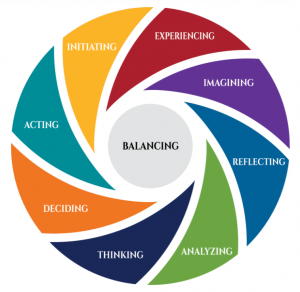What's Your Style?

Inspiration, Leadership
November 29, 2017
Kay Peterson
Topics
Actions, Authentic, Leadership Development, VisionExpanding Leadership Effectiveness with Learning Styles
In How You Learn Is How You Live: Using Nine Ways of Learning to Transform Your Life, we identify nine approaches to learning and life. These styles are dynamic ways of navigating the learning cycle, emphasizing some parts of the cycle over others. Learning styles are not traits or pigeonholes; they are more like a habit or steady state. Thus, styles are self-reinforcing; we find a sweet spot in the way we navigate the learning cycle and continue to perfect that approach. We lead with our preferred style and default to it when we are on automatic pilot or under stress.
Each of the learning styles is associated with a step in any process and each also represents a part of a whole person. In total, the nine learning styles give us access to capabilities that are broad enough to successfully manage any situation and present a complete portrait of our total potential.

Source: Kolb, D.A. & Kolb, A.Y. Experience Based Learning Systems2016© Kay Peterson and David A. Kolb
Identify your own preferences:
Experiencing: Be present and deeply involved in a direct, subjective experience. Focus on feelings.
Imagining: Reflect on the experience and consider a range of possible options and solutions. Focus on including and helping.
Reflecting: Connect experiences and ideas through sustained reflection, taking time to consider many perspectives. Focus on observing.
Analyzing: Organize information into concise models and systems through reflection to create a plan. Focus on data.
Thinking: Use disciplined logic or math to generalize and account for biases. Focus on rational thought.
Deciding: Commit to a single course of action to solve a problem or achieve practical results. Focus on one goal.
Acting: Take assertive, directed action to accomplish a goal. Focus on results.
Initiating: Initiate new courses of action. Focus on new opportunities.
Balancing: Adapt by moving between Experiencing, Reflecting, Thinking and Acting as the situation demands, not using any one style to an extreme. Focus on adaptability.
Most people have a primary preference for one learning style and use backup styles. For instance, Anna had a preference for the Thinking style and used the Analyzing and Deciding styles as back up styles. This meant that Anna gravitated to situations that required problem-solving, analysis and goal setting. Because she underutilized other styles such as Initiating, Experiencing and Imagining, she avoided situations that called for working on teams or having difficult conversations.
Learning styles raise self-awareness by providing a model for understanding our strengths within the context of our whole potential, letting us see where some of our capabilities are strong and others are unrealized potential. As leaders, recognizing the various learning styles can illuminate the communication problems that arise when someone we know is “coming from a different place.” Appreciating the differences between learning styles can strengthen and balance our relationships with organizations, teams, and families as we discover how our weaknesses are covered by another’s strengths and vice versa.
How can you expand your style repertoire? Experiential Learning foundational scholar Carl Rogers believed that, paradoxically, change occurs when we become what we are rather than trying to be what we are not. You can practice becoming more curious and be accepting of yourself, and help those you lead to do the same. “Zoom out” at times throughout the day to witness yourself in action. Notice which styles you use and which you avoid. By honoring your primary style preference, you will build self-awareness and a firm foundation for your current strengths and challenges. Only then can you begin to change and become more flexible in your approach.







